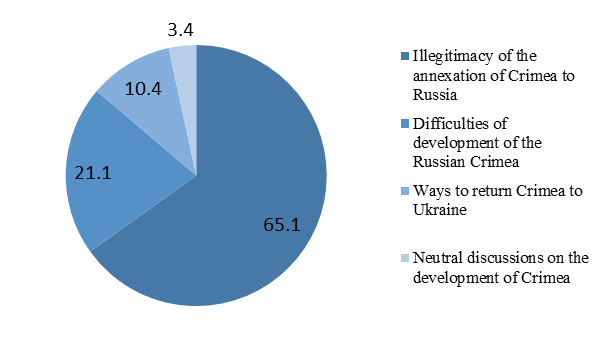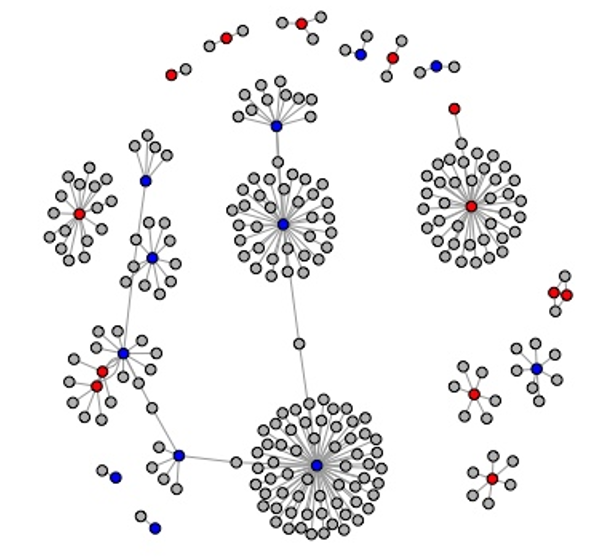Abstract
The article presents the results of the study of Ukrainian social media flows and online communities, which reflect the problems of the Crimea and Sevastopol development as Russian parts. The design of the study contained methods of cognitive mapping, automated Social Media Analytics (using IQBuzz social media monitoring service) and analysis of social graphs (using the author's software). Cognitive mapping of the most influential Ukrainian blogs in which public opinion is shaped on issues of Crimean society integration in the Russian socio-cultural space provided data on the proportion of messages that express various positions of the Ukrainian users on the reunification of Crimea, Sevastopol and Russia, on the thematic palette discussed in these topics as well as the construction technologies at Russian-speaking users opinions on the status and development issues of the Crimean society nowadays. Automated Social Media Analysis revealed the extent of user audience involvement in disintegrating social-media streams about the problems of the Russian Crimea, segmented streams by content types. The analysis of social graphs allowed to define the key opinion leaders of online communities forming deconsolidation discourses of the Crimean and Sevastopol communities, revealed the features of interaction within influential online groups focused on social destabilization of Crimea as a Russian region.
Keywords: Development problemssocial media analyticscognitive mappingsocial graphs analysisdigital opinion leadersnetwork group influence
Introduction
The rapid development of social media leads to the increase in the use of mobile disintegrating attitudes of users for some political reasons. In the transitional period of integration of the Crimean and Sevastopol communities into the Russian socio-cultural space, attempts to destabilize the public opinion of the Peninsula inhabitants regarding the future of the Russian Crimea are intensifying. To assess the scale and nature of this process, it is advisable to use the capabilities of Big Data analysis. One of the Big Data key methods is the Predictor Mining. It based on automated extraction of patterns from large amounts of data for the analysis and forecasting socio-political processes. Based on Predictor Mining principles Social Media Analytics is the Big Data method which considers using markers-digital traces of social and behavioural attitudes: words, phrases representing in social media. This method provides possibility to analyze such parameters as content, dynamics and structure of information flows reflecting attempts to destabilize so called Crimean consensus.
Problem Statement
The problem of the study is to identify the possibilities of Social Media Analysis as a Big Data method for the social media streams scale, dynamics and discourses which aimed at deconsolidation of the Crimean and Sevastopol communities. The scale of influence involves determining the size of the user audience involved in the disintegration flows. The dynamics are related to changes in the intensity of social media streams over time. Discourses show the meanings formed by online opinion leaders to mobilize disintegrating attitudes of Crimean and Sevastopol residents.
Research Questions
Research questions that can be answered by using Social Media Analysis are follows. What is the referential of the "Russian spring" in social media? What is the weight, direction and types of discourses of international social and media flows? What is the protest potential of users. What is the potential pressure of external information flows on the consciousness of users-residents of Crimea and Sevastopol?
Purpose of the Study
The study is aimed at identifying the specific weight and content characteristics of various discourses, reflecting the position of the most influential Ukrainian blogs and new media channels on the problems of development of Crimea and Sevastopol in Russia. Among the important issues of the subject field of the study is the definition of the technologies used by the leaders of social media to form a negative public opinion of the user audience in relation to the integration of the Crimean society into the socio-cultural space of the Russian Federation. A separate area of analysis is to identify the structure of relationships between subscribers of online communities discussing the problems of Russian Crimea and the characteristics of their user activity.
Research Methods
The design of the study contains:
1. Cognitive mapping of Ukrainian blogs and new media channels, selected according to two basic criteria: relevance of topics discussed in social media, the subject of the study and the audience (number of subscribers), exceeding 50,000 people. A total of 25 social media were selected, all reports of these sources dated from 01.06.2015 to 31.05.2018, which included a mention of the topic of the annexation of Crimea/Sevastopol to Russia and the development of the Peninsula after March 2014 (studied in a total of 5,000 documents), were subject to analysis. The authors of all accumulated documents are stationed on the territory of Ukraine. Their use of the Russian language is due, obviously, to the installation of influence on the mass consciousness of the Russian-speaking population, especially the Crimean Peninsula and all Russian citizens. The study of the content of blogs and new media channels was based on the following parameters:
- the ratio of the shares of social and media messages representing different sides of the topic of the annexation of Crimea/Sevastopol to the Russian Federation and their development in Russia;
- type of speech practice strategies used in the analyzed new media;
- social media triggers of protest activity (Brodovskaya, Dombrovskaya, Karzubov, & Sinyakov, 2017).
2. Discourse analysis of social media users messages relevant to the research topic, development on its basis of dictionaries of digital markers of types of messages of Ukrainian information flows in the Crimean segment of social media for automated unloading of the array of big data. Discourse analysis was also used at the stage of identifying protest metaphors and techniques of forming anti-Russian rhetoric in Ukrainian information flows circulating in the Crimean segment of social media (Huang, Brodovskaya, Dombrovskaya, Kazachenko, & Karzubov, 2018).
3. Social media analysis of spontaneous and purposeful information flows in social media-data sets of automated Internet content uploading – 1 million messages of users of Vkontakte, Odnoklassniki and Facebook networks. The method allowed to segment Ukrainian information flows in the Crimean segment of social media, to identify their structural, content and dynamic characteristics (Brodovskaya, Dombrovskaya, & Batanina, 2019).
4. Analysis of social graphs of online communities-10 online communities relevant to the research topic; analysis of the density of social links-10 online communities. This method was used to determine the integration of participants and to identify the density of social links between online communities coordinated by Ukrainian actors (Brodovskaya, Dombrovskaya, & Karzubov, 2017).
To develop the research tools, the following concepts were take into account: concept of political networks (Blatter, 2003) focusing on the mobilizing functions of political institutions; actor-network theory (Latour, 2017) reflecting the idea of the formation and strengthening of actors, primarily in interaction in the network; the concept of cyberspace (Nye, Butt, Bradburn, & Prasad, 2018) considering information as a tool of domination; the concept of managing personal interactions online (Buchanan, Vermund, Friedman, & Spiegelman, 2018) analyzing digitalization as a key component of global processes; structure of user interaction in the process of political communication online (Castells, Cartier, & Qiu, 2005), principles of shaping social media images (Gamson, Croteau, Hoynes, & Sasson, 1992).
Findings

According to figure
Table
Shown on the Table
Figure

Shown on Figure
Conclusion
The study showed that during the entire period of development of the Crimean society in the Russian Federation, Ukrainian network actors are actively working in the direction of mobilization of disintegration installations of Crimean citizens. At the same time, such triggers of opposition behaviour as discontent with oligarchic capitalism and corruption in power are used; the factor of split elites; the affinity of the protest wave with the election campaign; active addressing to youth and youth organizations; the resource of influence of external leaders. Often, the way to form negative attitudes towards the position of the Russian government about Crimea and Sevastopol is to spread stereotypical ideas about the actions of the authorities, simplifying the motives of its representatives. This provides a risk of developing irrational, affective attitudes in the user audience.
One of the means of increasing social tension is the factor of "vulnerable social groups", and, first of all, ethnic communities, "stigmatization" of situation with Ukrainians and Crimean Tatars, sticking "labels" of oppression of ethnic communities in Crimea and Sevastopol are used.
Online communities of anti-Russian rhetoric interacting with each other exploit the themes of the conflict in the South-East of Ukraine, exposing the Russian government as the only culprit in destabilizing this region and trying to undermine the positive attitudes of Crimean and Sevastopol residents towards integration into the Russian socio-cultural space.
Thus, the problem of consolidation of society and the challenges of the communication spaces of a global network associated with the risk of social destabilization requires the formation and propagation of alternative constructive social-media streams, opposing arrays of posts that do not meet the social development and threatening unity and harmony in Russian society.
Acknowledgments
The study is implemented with the funds of the grant of Russian Foundation for Basic Research " Ukrainian information flows in the Crimean segment of social media: risks and technologies to overcome the negative effects of anti-Russian rhetoric in the online environment (№ 18-011-00937 for 2018-2020).
References
- Blatter, J. (2003) Beyond Hierarchies and Networks: Institutional Logics and Transboundary Spaces. Governance: An International Journal of Policy Administration Institutions, 16(4), 503–526.
- Brodovskaya, E., Dombrovskaya, A., & Batanina, I. (2019) Information streams for inter-ethnic relations in Crimea and Sevastopol: SMA and discourse analysis of posts in social networks of Runet. In: Chugunov A., Misnikov, Y., Roshchin, E., & Trutnev, D. (Eds), Proceedings of International Conference on Electronic Governance and Open Society: Challenges in Eurasia. Communications in Computer and Information Science, 947, pp. 363-373. Cham: Springer. https://doi.org/10.1007/978-3-030-13283-5_27
- Brodovskaya, E. V., Dombrovskaya, A. Yu., & Karzubov, D. N. (2017) Online mobilization of mass protests in Ukraine, Moldova, Armenia, and Kazakhstan (2013 - 2016): the results of comprehensive comparative empirical. In Schimmer, M., Polezhaeva, O., & Trutnev, D. (Eds.), Proceedings of the International Conference on Electronic Governance and Open Society: Challenges in Eurasia. New York, NY: ACM. https://doi.org/10.1145/3129757.3129764
- Brodovskaya, E. V., Dombrovskaya, A. Yu., Karzubov, D. N., & Sinyakov, A. V. (2017) Developing methodology for “smart” search for political process markers in social media. Monitoring of Public Opinion: Economic and Social Changes, 5, 79-104. https://doi.org/10.14515/monitoring.2017.5.06
- Buchanan, A. L., Vermund, S. H., Friedman, S. R., & Spiegelman, D. (2018) Assessing Individual and Disseminated Effects in Network-Randomized Studies // American Journal of Epidemiology, 187(11), 2449-2459. https://doi.org/10.1093/aje/kwy149
- Castells, M., Cartier, C., & Qiu, J. (2005). The information have-less: Inequality, mobility, and translocal networks in Chinese cities. Studies in Comparative International Development, 40(2), 9-34. https://doi.org/10.1007/BF02686292
- Gamson, W. A., Croteau, D., Hoynes, W., & Sasson, Th. (1992). Media Images and the Social Construction of Reality. Annual Review of Sociology, 18, 373–393. https://doi.org/ 10.1146/annurev.so.18.080192.002105
- Huang, T. -Y. Brodovskaya, E., Dombrovskaya, A., Kazachenko, S., & Karzubov, D. (2018). Internet communication in different political systems: a cross-national study. XLinguae, 11(2), 471-482. https://doi.org/10.18355/XL.2018.11.02.38
- Latour, B. (2017). On actor-network theory. A few clarifications, plus more than a few complications. Logos, 27(1), 173-200. https://doi.org/10.22394/0869-5377-2017-1-173-197
- Nye, C. D., Butt, S. M., Bradburn, J., & Prasad, J. (2018). Interests as predictors of performance: An omitted and underappreciated variable. Journal of Vocational Behavior, 108, 178-189. https://doi.org/10.1016/j.jvb.2018.08.003
Copyright information

This work is licensed under a Creative Commons Attribution-NonCommercial-NoDerivatives 4.0 International License.
About this article
Publication Date
09 March 2020
Article Doi
eBook ISBN
978-1-80296-078-5
Publisher
European Publisher
Volume
79
Print ISBN (optional)
-
Edition Number
1st Edition
Pages
1-1576
Subjects
Business, business ethics, social responsibility, innovation, ethical issues, scientific developments, technological developments
Cite this article as:
Dombrovskaya*, A., Brodovskaya, E., & Azarov, A. (2020). Online Groups On Development Of Crimea And Sevastopol Issues: Social Media Analytics. In S. I. Ashmarina, & V. V. Mantulenko (Eds.), Global Challenges and Prospects of the Modern Economic Development, vol 79. European Proceedings of Social and Behavioural Sciences (pp. 921-927). European Publisher. https://doi.org/10.15405/epsbs.2020.03.133
